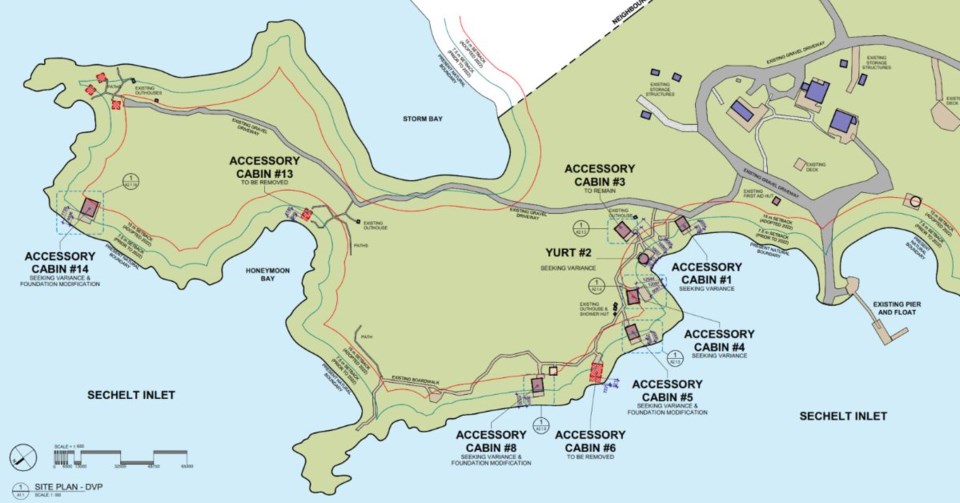An ask from Telus for a variance for one portion of its proposed re-development of Cawley Point into a wilderness retreat site was put on hold on July 20.
The Sunshine Coast Regional District’s Electoral Area Services Committee concluded it wanted to receive comment from affected areas. The application is for a development variance permit to retain five cabins, a yurt site and connecting boardwalks at its Storm Bay site on Sechelt Inlet (12 kilometres north of Sechelt). Those structures, and others that Telus proposed to removed, were built within as little as 2.5 metres of the inlet’s natural boundary. The regional district's Zoning Bylaw requires a 15 metre oceanfront setback.
Referrals the committee recommended were to its Halfmoon Bay and Pender Harbour/Egmont Advisory Planning Commissions and the District of Sechelt. The committee's motion requires approval at a future (July 27) board meeting to proceed.
Cabins built without permits
A staff report on the meeting’s agenda supported granting Telus’s application, citing “technical rationale from both geo-technical and environmental perspectives by both reports supporting the retention of the boardwalks and five cabins." At the meeting, staff called the permits a “reasonable approached to resolve the non-compliance issues of the structures” and acknowledged that five letters of opposition to the application had been received.
The committee did not adhere to staff’s advice on proceeding with the permit. In a decision to recommend additional referrals, opinions expressed by area directors as well as members of the public who spoke at the meeting were factored in. Those comments highlighted that Telus had the cabins constructed without regional district permits or inspections on sites previously occupied by temporary structures (tents and yurts) placed there by the previous owner of the property.
Committee chairperson, Elphinstone area director Donna McMahon, remarked that despite receiving a consultant’s report in 2020 that identified a Department of Fisheries and Oceans recommendation for oceanfront protection areas of 30 metres, Telus had construction work done on 13 locations within those and regional district required setbacks.
Roberts Creek area director Kelly Backs said that construction in violation of known setbacks and without permits, “didn’t sit well” with him.
Five audience members attending the meeting online and in person spoke in opposition to the application. Their statements focused on concerns about the impacts of Telus’s proposals for the area as well as setting precedent by allowing an applicant who built without permits to receive approvals and setback relaxations after the fact. Questions raised included, “Why should a big corporation with lots of resources and consultant be allowed to do something an ordinary citizen on the Sunshine Coast is not allowed to do?” And, "How did this happen without anybody noticing?” And, “Are there other non-permitted activities taking place on the property?"
“Those cabins are the thin edge of the wedge,” said Tuwanek area resident John Carsley. He spoke to his concerns about what granting of a development variance permit could indicate for the consideration of Telus’s application for re-zoning of the 124 acre property, which has yet to go public in full detail.
Would relocating cabins be worse for the environment?
Earlier in the meeting, planning consultant working with Telus on the Cawley Point project Angela Letman provided an overview of the variance permit application. For the area within the 15-metre oceanfront setback zone, that included a plan to apply for all necessary permissions for the structures that the company plans to retain and removal of two cabins and three temporary structure platforms. In addition, three sites on the property outside of the oceanfront setback area would be subject to a “natural landscape restoration plan” that would be subject to regional district and shíshálh Nation review and monitoring.
She noted that should Telus be required to remove the cabins and boardwalks that were the subject of this application, requests to rebuild a similar number of structures elsewhere on the property would likely be filed. Proceeding with new construction in locations that respect bylaw oceanfront setback requirements would result in more tree cutting and natural area disturbance, she stated.
As for the full site zoning amendment application, Letman estimated that would be coming forward either late this year or early in 2024.


